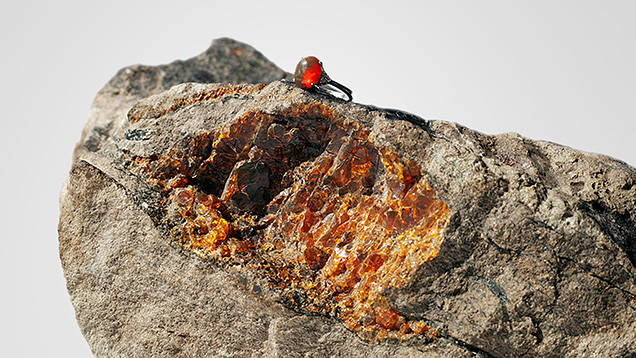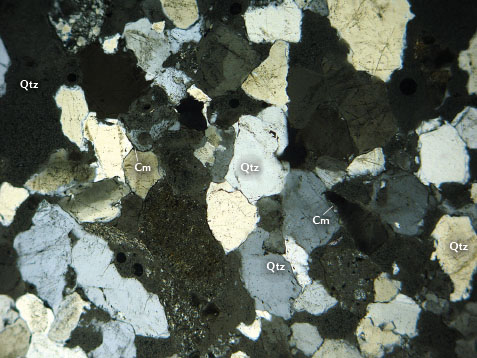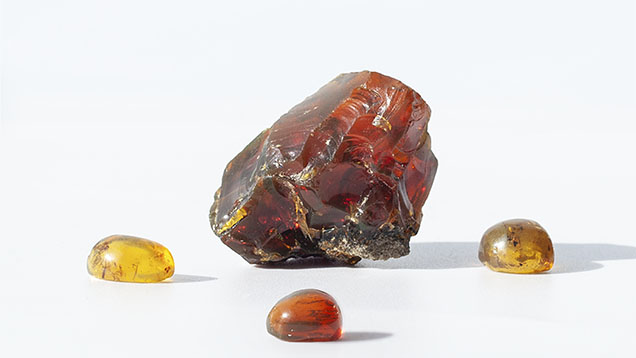Characteristics of Newly Discovered Amber from Phu Quoc, Vietnam

ABSTRACT
The authors examine the gemological properties and commercial potential of a new source of amber, discovered in 2020 on the Vietnamese island of Phu Quoc. It is the only known amber locality in Vietnam so far. The Phu Quoc amber possesses reddish orange to orangy yellow hues and is transparent, with sizes up to 10 cm. The samples exhibited strong blue fluorescence under ultraviolet light (both long-wave and short-wave). Internally, they displayed disk-like inclusions and gas bubbles, but few botanical inclusions were found. Their characteristic FTIR peaks can be distinguished from those of amber found in other sources worldwide. Although amber from Phu Quoc is a recent discovery and has only been investigated in two small areas, its commercial potential is promising based on the samples’ quality and the wide distribution of the host rock on the island.

Amber, an organic gemstone fossilized from tree resin (Ross, 1999), comes from several sources globally, most notably the Baltic region, Myanmar, the Dominican Republic, and Indonesia. Amber from each locality shows distinctive characteristics. In 2020, a sandstone miner working on the Vietnamese island of Phu Quoc came across an orange-yellow material buried inside the sandstone layers. He collected loose and bedrock-hosted samples, the largest up to 10 cm (figure 1), and submitted them to Liu Gemological Research and Application Center (LIULAB) in Ho Chi Minh City, where they were identified as amber. With the miner’s help, the authors visited the site to collect amber samples. During our field trip, we found a second deposit, also in a sandstone mine, located about a kilometer from the first amber outcrop (figure 2).
In the present study, Phu Quoc amber was characterized with standard gemological methods and Fourier-transform infrared spectroscopy (FTIR). Our results, combined with other published data from Baltic, Burmese, and Dominican amber (Wolfe et al., 2009; Leelawatanasuk et al., 2013; Sun et al., 2015; Zhang et al., 2020), allowed us to compare the Phu Quoc samples with amber from commercially important sources.
GEOLOGICAL SETTING
The island of Phu Quoc lies in the Gulf of Thailand, about 45 km off the southwestern coast of Vietnam. The island has an area of 574 km2. The terrain consists mainly of low mountains, with the highest peak standing at 607 m (Duong et al., 1998). The amber sites found so far are in an area that is easily accessible by vehicle.
The geological formations in Phu Quoc are mostly sandstone and siltstone from the Miocene to the Holocene. The Phu Quoc amber source lies in the northern center of the island (figure 2), mainly containing Neogene sedimentary rocks, and is divided into two parts. The lower part is interbedded conglomerate, sandstone, and gray and green siltstone, distributed on the eastern margin of the island; the upper part is jet- and amber-bearing quartz sandstone with cross-bedding structure, distributed throughout most of northern Phu Quoc (My and Linh, 2005). The upper part is unconformably overlain by Holocene sediments.


The Phu Quoc amber is hosted in gray to whitish gray and fine- to medium-grained sandstone (My and Linh, 2005; Fyhn et al., 2010) (figure 3). Found in sandstone as nodules, samples are nearly round or distorted oval in shape, varying in size from a few centimeters to 10 centimeters. The boundary between amber and sandstone is clear but uneven and difficult to detach (figures 1 and 3). Surrounding amber in sandstone is black jet in the form of plates, with veins in matrix ranging in size from a few centimeters to several tens of centimeters. Part of the amber boundary is in contact with the sandstone, and the rest is attached to the jet. The sedimentary rocks containing amber are situated at a depth of about 15–20 m and are about 30 m thick, accompanied by lamellar-like jet. The amber-bearing sedimentary rock is quartz sandstone with massive structure. Rock-forming minerals are >90% quartz and <10% cement (sericitized clay minerals), as seen under a petrographic microscope (figure 4).
MATERIALS AND METHODS
A total of 38 amber samples (31 loose samples and 7 samples in matrix) were collected from two locations (sites 1 and 2) on November 17 and 18, 2020. These consisted of 26 samples (22 loose and 4 in matrix) from site 1 and 12 samples (nine loose and three in matrix) from site 2. In addition, we received three samples (two loose and one in matrix) from the sandstone mine worker from site 1. Twelve of the Phu Quoc samples were used for research analysis: two loose samples (nos. 1 and 2) from the mine worker, and ten samples (nos. 3–12: eight loose and two in matrix) from the authors’ set of 38 samples from both sites (figure 2). The samples were chosen based on size and quality. Five samples were cut into cabochons by one of the authors (PMT), and seven were kept rough (figure 5). For refractive index and FTIR measurements, the authors selected rough samples that had at least one flat-polished surface, were free of pores, and weighed more than 5 ct. The amber-bearing sandstones consisted mainly of amber and jet.

We used three additional samples from Myanmar (A-3), the Baltic Sea (Poland, A-2), and the Dominican Republic (A-1) to compare with the Phu Quoc amber by conducting gemological testing and FTIR advanced analysis at LIULAB (figure 5). Those three samples belong to the collection of minerals and gems of the Faculty of Geology, University of Science, Ho Chi Minh City.
Standard gemological methods were used to confirm the identity of the studied samples as amber. The amber’s color was observed under a 60 W GLS LED daylight bulb (5000–6000K). Specific gravity values for samples 1–6 and 9–12 were measured using a hydrostatic scale, and their refractive indexes were recorded with a standard gemological refractometer. A polariscope was used to observe optical features on the same samples. Fluorescence reaction was tested on all the samples under ultraviolet light, both long-wave (365 nm) and short-wave (254 nm). Internal features were observed under a Carton SPZV50 gemological microscope with 7× to 50× magnification. A 3 μm thin section of amber-bearing sandstone was examined under an Olympus CH-2 petrographic microscope at magnifications of 100×, 200×, and 400×.
For all samples, a hot needle test was applied to check for the characteristic scent of natural resin. We also checked the reaction to acetone as a means of separating amber from copal. Amber does not react with acetone, while copal reacts with acetone after 20 seconds (Ross, 1999).
Twelve amber samples—nine from Phu Quoc and one each from the Baltic Sea, Myanmar, and the Dominican Republic—were analyzed using an Agilent Cary 630 FTIR spectrometer. Data were acquired with a spectral range of 4000–650 cm–1, a resolution of 8 cm–1, and a scan time of 32 s.
RESULTS AND DISCUSSION
Under daylight-equivalent illumination, the amber samples from Phu Quoc were predominantly reddish orange or orangy yellow. Black patches and spots in some samples (6 and 10) were preserved flora (tree bark). The samples exhibited predominantly subvitreous to resinous luster, and many samples displayed good transparency (figure 5). The samples also exhibited a white streak.


Gemological Characteristics. The specific gravity values of the 10 tested samples ranged from 1.03 to 1.04, corresponding to the SG of amber (Ross, 1999; Sun et al., 2015). These same 10 samples were singly refractive and had refractive index values ranging from 1.540 to 1.543, also consistent with amber (Ross, 1999; Sun et al., 2015) (table 1). Under long-wave and short-wave UV light, all Phu Quoc amber samples displayed strong to very strong light blue fluorescence (figure 6, top). They emitted green fluorescence on the surface under daylight-equivalent illumination (figure 6, bottom right) or against a dark background. The fluorescence phenomenon of the Phu Quoc amber is similar to that of Dominican and Indonesian amber (Poinar, 2010; Leelawatanasuk et al., 2013; Liu et al., 2014; Kocsis et al., 2020; Zhang et al., 2020). However, the Phu Quoc amber showed weaker fluorescence under daylight than Dominican or Indonesian amber.
Hot needle testing on all 12 amber samples released the natural scent of resin, distinguishing it from the burning scent of synthetic polymer (Ross, 1999). None of the Phu Quoc samples reacted to acetone, proving they were amber and not copal (Ross, 1999).
Optical Characteristics. Under the polariscope, the Phu Quoc amber presented the phenomenon of alternately blinking light and dark when rotated every 45°. Although there are no detailed studies to explain the phenomenon, this optical characteristic known as anomalous double refraction (ADR) is commonly seen under a polariscope. Accordingly, internal stress helps to explain the degree of anomalous extinction in amber (Kratochvíl, 2009).

Internal Characteristics. The Phu Quoc samples contained four types of internal characteristics: gas bubbles, disk-like inclusions (spangle) with a colorless core inside, round-film inclusions, and flora inclusions (figure 7 and table 1). Gas bubble inclusions indicating the origin as tree resin (viscous and cool) are found in amber from most sources worldwide. In Phu Quoc samples, the gas bubble inclusions were accompanied by a typical flow structure. The disk-like inclusions contained air bubbles at the center, suggesting the condition of Phu Quoc amber, which were influenced by geothermal heat due to sedimentary depth (depth of burial) (Ross, 1999). Round-film inclusions are quite commonly seen, and they are also the spangles that reflect light to create interference colors. The flora inclusions were remnants of reddish brown wood fibers. Significantly, insects were not found in any of the amber samples inspected, unlike amber from most other sources (Penney, 2016).

FTIR Analysis. The FTIR spectra of the Phu Quoc samples shown in figure 8A include peaks at 2923, 2861, 2100, 1695, 1455, 1379, 1261, 1156, 970, and 815 cm–1. The FTIR results of Baltic, Burmese, and Dominican amber are shown in figure 8, B–D. The results were consistent with previously published FTIR spectra of Burmese amber (Jiang et al., 2020), Baltic amber (Guiliano et al., 2007; Wolfe et al., 2009), and Dominican amber (Xin et al., 2021).
Phu Quoc amber exhibited an absorption band at around 2900 cm–1 with two peaks at 2923 and 2861 cm–1, representing the stretching vibration of the sp3 hybridized C-H bond of the methyl and methylene groups (Guiliano et al., 2007). These are the typical absorption bands of amber and plastic or materials containing the C-H bond.
In the range of 2800–1800 cm–1, Phu Quoc amber displayed a weak band at 2100 cm–1 caused by alkyne C≡C stretching, which was similar to that of Dominican samples. Meanwhile, Burmese and Baltic amber did not show any significant bands in this region.
The spectral range between 1800 and 1200 cm–1 for Phu Quoc amber included a peak at 1455 cm–1 for methylene (CH2) bending and another at 1379 cm–1 for methyl (CH3) bending (Pavia et al., 2014). The strong absorption bands at 1695 and 1261 cm–1 are related to C=O stretching and C-O carbonyl bonds, respectively (possibly ester and acid). The simultaneous presence of the peaks shows that there are many types of carbonates in this amber’s composition (Sun et al., 2015). In the 1800–1200 cm–1 range, the spectral absorption bands were similar to those of the Dominican samples. Meanwhile, the absence of a 1261 cm–1 peak in Burmese and Baltic amber differentiated them from Phu Quoc amber.
Between 1200 and 800 cm–1, the Phu Quoc amber displayed weak absorption peaks at 1156, 970, and 815 cm–1, while Burmese, Baltic, and Dominican amber displayed medium absorption peaks at 1149, 1031, 975, and 813 cm–1. The weak 1156 cm–1 peak is assigned to C-O stretching of tertiary alcohol (Pavia et al., 2014). Additionally, the Baltic amber presented a spectral peak at 888 cm–1. For Phu Quoc amber, no peaks were detected at 3048, 1642, and 887 cm–1, proving it was genuine amber rather than copal (Sun et al., 2015).
The FTIR spectra of Phu Quoc samples exhibited characteristics similar to those of Baltic, Burmese, and Dominican amber. However, the spectra of Phu Quoc amber displayed some characteristics unique to the deposit. The existence of 1261 and 1156 cm–1 bands and the absence of 3450 and 1149 cm–1 peaks revealed distinguishing features in both composition and polymer structures. These differences play an important role in defining the geographic origin of amber from global sources (including Phu Quoc amber).
COMMERCIAL POTENTIAL
Based on our initial evaluation, Phu Quoc amber is of high enough quality to be suitable for jewelry manufacturing (figures 1 and 9). The color ranges from highly valued yellowish orange to orangy red, similar to that of Baltic and Burmese amber. Most are transparent, especially the samples smaller than 1 cm. The Phu Quoc amber is suitable for cabochons and carvings. Although we carried out our research within a small area, the sandstone formation (amber host rock) covers almost the entire island (My and Linh, 2005), suggesting the possibility of finding amber over a wide area. While these factors signal the commercial potential of Phu Quoc amber, further assessment is needed.

CONCLUSIONS
Standard gemological properties, FTIR spectroscopy, and other tests confirmed that the samples represent the first Vietnamese source of amber. The material’s attractive color, transparency, and size make it suitable for jewelry. In addition, the wide distribution of the Neogene sandstone host rock on this island indicates strong commercial potential. With the discovery of amber on Phu Quoc, Vietnam could become an important supplier of this organic gem.



